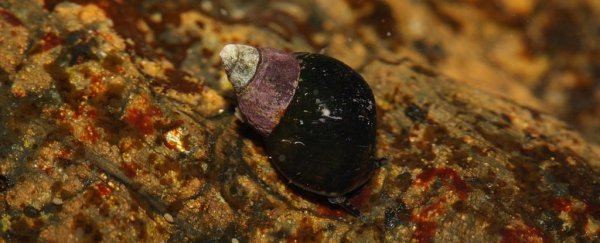Here's one to add to your list of things to be worried about at the beach: sea snails getting into your cuts.
An 11-year-old boy had a four-millimetre sea snail removed from his arm a week after he fell and scraped his elbow in a tide pool at a California beach.
Afterwards, his parents tried to keep the wound clean, but noticed a "blister" that wasn't going away. On the contrary, it was growing in size, so they took him to the doctor.
Albert Khait, an assistant professor of pediatrics at Loma Linda University, examined the boy and found him otherwise healthy, up to date with his immunisations, and not presenting with any serious symptoms, such as difficulty moving his arm, or fever.
But the abscess at the site was sore, red, full of fluid, and possibly developing into a bacterial infection.
The first thing doctors usually do to treat an abscess is to lance and drain it, so that is what Khait did. But inside, under all the pus, the doctor found a hard object, about 4 millimetres in diameter.
It was a sea snail, later identified as a chequered periwinkle (Littorina scutulata) - and it was apparently still alive.
 The sea snail removed from the patient's left elbow. (BMJ Case Reports)
The sea snail removed from the patient's left elbow. (BMJ Case Reports)
So how does a sea snail survive in a pus-filled abscess? Apparently it has something to do with its shoreline habitat.
"Periwinkles are herbivores, feeding primarily on algae from rocks in the high tidal zones. As a result of living in this habitat, they are often exposed to air and have the capability to close their shell tightly onto firm surfaces with a horny operculum and a glue-like mucous," Khait wrote in his case report.
"This allows them to preserve water and moisture inside their shell, therefore avoiding desiccation and suffocation. These characteristics make the chequered periwinkle a unique visitor into the human body and appear to have allowed this organism to survive despite the extreme environment of the host."
After the extraction, and a course of antibiotics, the boys arm fully recovered.
Khait scoured medical literature, and found no previously reported cases of sea snails living in humans, but that doesn't mean it hasn't happened before.
In 2013, a couple told CNN that they had found a sea snail growing in their four-year-old son's knee after he had scraped it on a California beach. The case was almost exactly the same: a growing, pus-filled abscess, with a tiny living sea snail inside.
Khait believes that the wounds may have become "inoculated" by sea snail eggs that become attached to rocks in tide pools after the female snail lays them in the water.
That wasn't the only similarity between the two cases. Both boys were apparently delighted by their surprise snails, and took them home to keep as pets. The four-year-old named his snail "Turbo".
Meanwhile, the 11-year-old patient "was visibly excited about the surprising discovery and requested to keep the specimen so he could share the story with family and friends," Khait wrote.
Unfortunately, it doesn't seem like the little pet snail made it.
"On follow-up phone conversation one week later, the wound had fully healed and the patient had made a full recovery. The family reported movement of the sea snail one day following removal, but no further movement thereafter," the doctor noted in the case report.
Awww.
The paper was published in the journal BMJ Case Reports.
